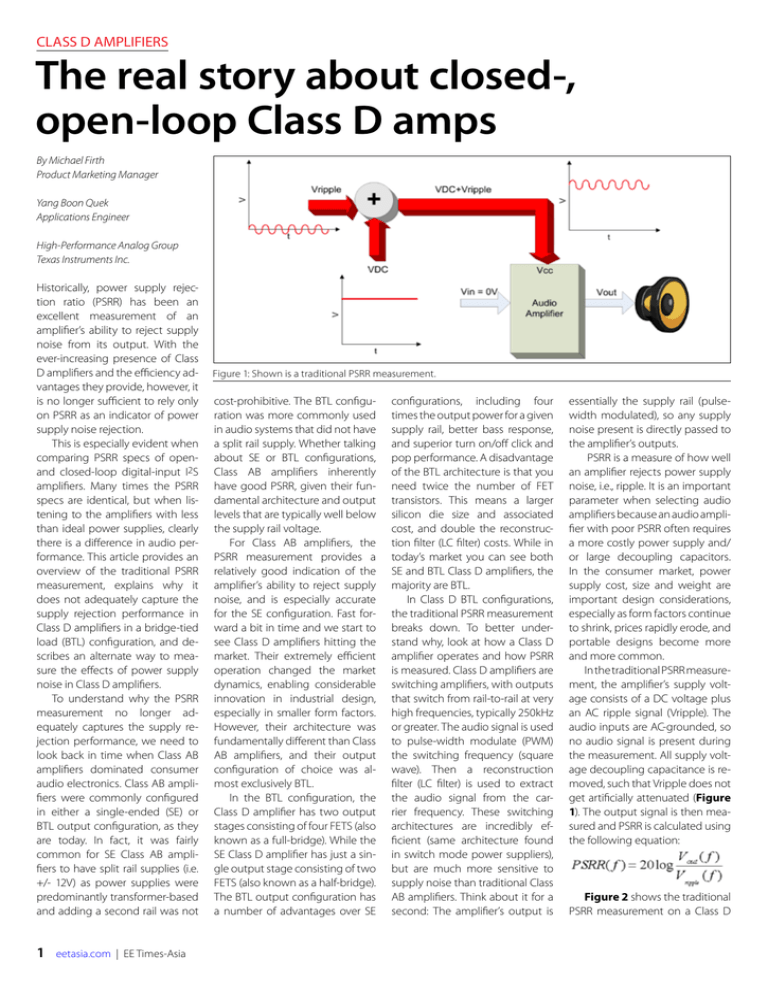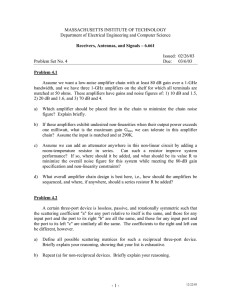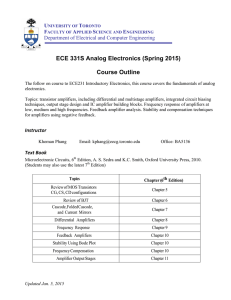The real story about closed-, open-loop Class D amps
advertisement

CLASS D AMPLIFIERS The real story about closed-, open-loop Class D amps By Michael Firth Product Marketing Manager Yang Boon Quek Applications Engineer High-Performance Analog Group Texas Instruments Inc. Historically, power supply rejection ratio (PSRR) has been an excellent measurement of an amplifier’s ability to reject supply noise from its output. With the ever-increasing presence of Class D amplifiers and the efficiency advantages they provide, however, it is no longer sufficient to rely only on PSRR as an indicator of power supply noise rejection. This is especially evident when comparing PSRR specs of openand closed-loop digital-input I2S amplifiers. Many times the PSRR specs are identical, but when listening to the amplifiers with less than ideal power supplies, clearly there is a difference in audio performance. This article provides an overview of the traditional PSRR measurement, explains why it does not adequately capture the supply rejection performance in Class D amplifiers in a bridge-tied load (BTL) configuration, and describes an alternate way to measure the effects of power supply noise in Class D amplifiers. To understand why the PSRR measurement no longer adequately captures the supply rejection performance, we need to look back in time when Class AB amplifiers dominated consumer audio electronics. Class AB amplifiers were commonly configured in either a single-ended (SE) or BTL output configuration, as they are today. In fact, it was fairly common for SE Class AB amplifiers to have split rail supplies (i.e. +/- 12V) as power supplies were predominantly transformer-based and adding a second rail was not eetasia.com | EE Times-Asia Figure 1: Shown is a traditional PSRR measurement. cost-prohibitive. The BTL configuration was more commonly used in audio systems that did not have a split rail supply. Whether talking about SE or BTL configurations, Class AB amplifiers inherently have good PSRR, given their fundamental architecture and output levels that are typically well below the supply rail voltage. For Class AB amplifiers, the PSRR measurement provides a relatively good indication of the amplifier’s ability to reject supply noise, and is especially accurate for the SE configuration. Fast forward a bit in time and we start to see Class D amplifiers hitting the market. Their extremely efficient operation changed the market dynamics, enabling considerable innovation in industrial design, especially in smaller form factors. However, their architecture was fundamentally different than Class AB amplifiers, and their output configuration of choice was almost exclusively BTL. In the BTL configuration, the Class D amplifier has two output stages consisting of four FETS (also known as a full-bridge). While the SE Class D amplifier has just a single output stage consisting of two FETS (also known as a half-bridge). The BTL output configuration has a number of advantages over SE configurations, including four times the output power for a given supply rail, better bass response, and superior turn on/off click and pop performance. A disadvantage of the BTL architecture is that you need twice the number of FET transistors. This means a larger silicon die size and associated cost, and double the reconstruction filter (LC filter) costs. While in today’s market you can see both SE and BTL Class D amplifiers, the majority are BTL. In Class D BTL configurations, the traditional PSRR measurement breaks down. To better understand why, look at how a Class D amplifier operates and how PSRR is measured. Class D amplifiers are switching amplifiers, with outputs that switch from rail-to-rail at very high frequencies, typically 250kHz or greater. The audio signal is used to pulse-width modulate (PWM) the switching frequency (square wave). Then a reconstruction filter (LC filter) is used to extract the audio signal from the carrier frequency. These switching architectures are incredibly efficient (same architecture found in switch mode power suppliers), but are much more sensitive to supply noise than traditional Class AB amplifiers. Think about it for a second: The amplifier’s output is essentially the supply rail (pulsewidth modulated), so any supply noise present is directly passed to the amplifier’s outputs. PSRR is a measure of how well an amplifier rejects power supply noise, i.e., ripple. It is an important parameter when selecting audio amplifiers because an audio amplifier with poor PSRR often requires a more costly power supply and/ or large decoupling capacitors. In the consumer market, power supply cost, size and weight are important design considerations, especially as form factors continue to shrink, prices rapidly erode, and portable designs become more and more common. In the traditional PSRR measurement, the amplifier’s supply voltage consists of a DC voltage plus an AC ripple signal (Vripple). The audio inputs are AC-grounded, so no audio signal is present during the measurement. All supply voltage decoupling capacitance is removed, such that Vripple does not get artificially attenuated (Figure 1). The output signal is then measured and PSRR is calculated using the following equation: Figure 2 shows the traditional PSRR measurement on a Class D BTL audio amplifier. The supply noise is clearly present on the output, both before and after the reconstruction filter. However, note that the noise is present and in-phase across the load. So when you measure the PSRR, the Vout+ and Vout– ripple cancel each other, yielding a false indication of supply rejection. But it’s clear that the amplifier is passing the supply noise directly to the outputs. This PSRR measurement is not giving you any indication of how good or not so good the amplifier is at rejecting the supply noise. Where the PSRR measurement breaks down is the inputs are AC-grounded during the measurement. In the real world, the amplifier is playing music; this is where things start to get interesting. When playing audio, the power supply noise gets mixed/ modulated with the incoming audio signal and its resulting distortion is spread throughout the audio band to varying degrees. The inherent canceling effect of the BTL configuration can no longer remove the noise. The industry came up with a really cool sounding name for this: intermodulation distortion (IMD). Figure 2: Shown is a BTL Class D PSRR measurement with LC filters. IMD is the result of two or more signals of different frequencies being mixed together, forming additional signals at frequencies that, generally are not at harmonic frequencies (integer multiples) of either. Before discussing how to address the deficiencies of the PSRR measurement, let’s first Figure 3: Shown is the TAS5706 closed-loop intermodulation sweep. eetasia.com | EE Times-Asia talk about feedback. If you have had your coffee and are following along with this argument, it should come as no surprise that Class D amplifiers inherently have problems with supply noise. This would be a major problem if not for feedback. (In high-end audio applications, open-loop amplifiers sound great, but that is a different story. They typically have very stable, high-performing supplies and much higher cost targets.) To compensate for supply noise sensitivity, designers either design a system with a well-regulated supply, which adds cost; or use a Class D amplifier that has feedback (also known as a closed-loop amplifier). Today, in the consumer elec- tronics market the majority of analog input Class D amplifiers are closed-loop. But it’s a different story with the digital-input I2S amplifiers. I2S amplifiers connect directly to the audio processor or audio source via a digital bus. This reduces cost and improves performance by eliminating the unnecessary D/A conversion. Unfortunately, there are not a lot of closed-loop I2S amplifiers on the market today as it’s fairly difficult to construct a feedback loop that samples the PWM output and sums it back with the incoming I2S digital audio stream. In an analog feedback system, you sum the analog output with the analog input, so it’s much easier to implement. But as the I2S market evolves, the majority of I2S amps should follow the same path as the analog-input amps and adopt feedback architectures. Clearly, PSRR is not a valid measurement of supply rejection for BTL Class D amplifiers. So what is one to do? Back to that cool sounding term, intermodulation. We need to measure the intermodulation distortion generated while playing audio and its corresponding THD+N Figure 4: Shown is the open-loop intermodulation sweep. profile. Before doing this, let’s go back to SE architectures. In SE architecture, whether it is Class AB, Class D or even Class Z, you don’t get the canceling effects of a BTL architecture since one end of the speaker is connected to the amplifier and the other is connected to ground. So in SE architecture, the traditional PSRR measurement provides a good indication of supply noise rejection, whether talking about Class AB or Class D amplifiers. Now let’s get into the lab and take some data. Below are a series of measurements where we analyze and compare power supply ripple IMD in an open-loop and closed-loop I2S amplifier. A digital 1kHz tone is injected into the amplifier’s inputs and a 100Hz, 500mVpp ripple signal is injected onto the supply. Observe IMD by taking an FFT of the differential outputs with the audio precision built-in FFT functions. Figure 3 shows the IMD measurement of a closed-loop I2S amplifier. Note the 1kHz input signal and almost non-existent Figure 5: As the ripple frequency increases, the frequency bandwidth affected by the distortion also increases. eetasia.com | EE Times-Asia sidebands. The feedback loop is doing a good job of suppressing the intermodulation distortion. The same IMD measurement is shown in Figure 4, but this time taken on an I2S open-loop amplifier. The sidebands at 900Hz and 1.1kHz are very pronounced since there is no feedback to suppress the IMD. Now, let’s get on to the good stuff. In Figures 3 and 4, you can clearly see the effects of the power supply noise IMD. But in terms of audio quality, IMD is a hard measurement to get your Figure 6: Feedback is suppressing the intermodulation distortion, so you don’t see any ripple noise effect on the audio performance. “qualitative hands” around. One option is to run the same experiment, but now measure the THD+N profile, which we will do in the next two measurements. The THD+N is measured with a 1kHz digital audio signal and 500mVpp power supply ripple. The supply ripple frequency is varied from 50Hz to 1kHz. In Figure 5, see the THD+N sweep of the open-loop part at different power supply ripple frequencies. The red line indicates the amplifiers performance with a no ripple present on the supply, representing the ideal case. The other curves represent ripple eetasia.com | EE Times-Asia frequencies varying from 50Hz to 1kHz. Note as the ripple frequency increases, the frequency bandwidth affected by the distortion also increases. Note that the open-loop performance is very good with a well regulated supply. However, that increases cost and can be problematic in today’s hyper-competitive world of consumer electronics. See the same THD+N sweeps in Figure 6, but now on the closed-loop amplifier. Feedback is suppressing the intermodulation distortion, so you don’t see any ripple noise effect on the audio performance. Conclusion In this article, we reviewed the traditional method of measuring PSRR and showed why it’s ineffective in measuring the effects of power supply ripple in BTL Class D amplifiers. The inherent canceling effects of the BTL output configuration coupled with a lack of audio signal present during the measurement yield a false reading. This is a critical deficiency of the specification as supply noise rejection performance is extremely important in selecting a Class D amplifier, especially in seeing the performance differences between digital-input (I2S) closed-loop and open-loop amplifiers. To get a more accurate picture of the supply noise rejection, you need to look at the IMD and THD+N performance with a 1kHz audio signal at the inputs and noise injected on the supply. Finally, we showed how the closed-loop Class D amplifier was able to compensate for the power supply noise, while the open-loop amplifier was not. In the hypercompetitive consumer electronics market, cost is king, and the ability of closed-loop architectures to reduce system cost is a very important design consideration.

